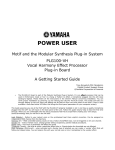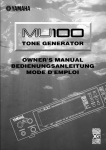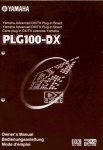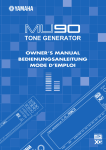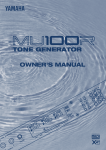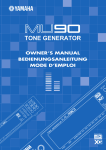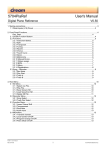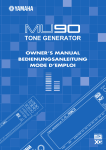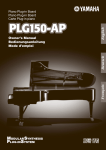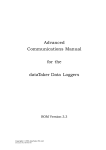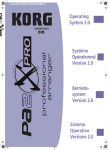Download Yamaha PLG100-XG Owner`s manual
Transcript
Precautions ● Do not expose the plug-in board to direct sunlight, excessive humidity, high temperatures, excessive dust or strong vibrations. ● Before handling the plug-in board, be sure to touch a metal surface to discharge any static electricity which may be in your body. ● When holding the plug-in board, do not touch the inside area of the circuit board or apply excessive pressure to the board, and be sure to protect the board from contact with water or other liquids. ● Before installing the plug-in board onto a tone generator/sound card, unplug the power connector of your computer. ● Before connecting the computer to other devices, turn off the power switches of all devices. ● Yamaha is not responsible for loss of data through computer malfunctions or operator actions. ● The plug-in board contains no user-serviceable parts, so never touch the inside area of the circuit board or tamper with the electronic circuitry in any way. Doing so may result in electrical shock or damage to the plugin board. YAMAHA CANNOT BE HELD RESPONSIBLE FOR DAMAGE CAUSED BY IMPROPER CARE AND USE OF THE PLUG-IN BOARD. * The company names and product names in this Owner’s Manual are the trademarks or registered trademarks of their respective companies. * The screens as illustrated in this owner’s manual are for instructional purposes only, and may appear somewhat different from the ones of your instrument. FCC INFORMATION (U.S.A.) 1. IMPORTANT NOTICE: DO NOT MODIFY THIS UNIT! This product, when installed as indicated in the instructions contained in this manual, meets FCC requirements. Modifications not expressly approved by Yamaha may void your authority, granted by the FCC, to use the product. 2. IMPORTANT: When connecting this product to accessories and/or another product use only high quality shielded cables. Cable/s supplied with this product MUST be used. Follow all installation instructions. Failure to follow instructions could void your FCC authorization to use this product in the USA. 3. NOTE: This product has been tested and found to comply with the requirements listed in FCC Regulations, Part 15 for Class ”B” digital devices. Compliance with these requirements provides a reasonable level of assurance that your use of this product in a residential environment will not result in harmful interference with other electronic devices. This equipment generates/ uses radio frequencies and, if not installed and used according to the instructions found in the users manual, may cause interference harmful to the operation of other electronic devices. Compliance with FCC regulations does not guarantee that interference will not occur in all installations. If this product is found to be the source of interference, which can be determined by turning the unit ”OFF” and ”ON”, please try to eliminate the problem by using one of the following measures: Relocate either this product or the device that is being affected by the interference. Utilize power outlets that are on different branch (circuit breaker or fuse) circuits or install AC line filter/s. In the case of radio or TV interference, relocate/reorient the antenna. If the antenna lead-in is 300 ohm ribbon lead, change the lead-in to co-axial type cable. If these corrective measures do not produce satisfactory results, please contact the local retailer authorized to distribute this type of product. If you can not locate the appropriate, please contact Yamaha Corporation of America, Electronic Service Division, 6600 Orangethorpe Ave, Buena Park, CA 90620 * This applies only to products distributed by YAMAHA CORPORATION OF AMERICA. CANADA This Class B digital apparatus complies with Canadian ICES-003. Cet appareil numérique de la classe B est conforme à la norme NMB-003 du Canada. • This applies only to products distributed by Yamaha Canada Music Ltd. • Ceci ne s’applique qu’aux produits distribués par Yamaha Canada Musique Ltée. 2 Introduction Congratulations and thank you for purchasing the Yamaha PLG100-VH Vocal Harmony Plug-in Board! The PLG100-VH is designed for use with the MU128 Tone Generator (as well as other MU-series instruments and the SW1000XG PCI Audio/MIDI Card), providing automatic and authentic sounding vocal harmony effects. It takes the sound of your voice (via a microphone and one of the A/D inputs) and reproduces it as a harmony vocal — providing up to four-part harmonies, including your original voice. The actual harmony notes can be controlled from a MIDI keyboard or sequencer, allowing you to perfectly match the harmony to chord changes. The settings and parameters of the PLG100-VH can also be conveniently edited with a Windows PC computer by using the VH Effect Editor software module (included in the XGworks Music Sequencer software). Table of Contents 4 Harmony Parameters ................................................ 12 Overview of the PLG100-VH ...................................... 4 Installing the PLG100-VH ........................................... 4 Included Items ............................................................. 4 Required and Recommended Items ......................... 5 Specifications ............................................................. 5 Troubleshooting .......................................................... 6 Harmony Type ........................................................... 12 Vocoder Harmony Parameters ................................. 13 Chordal Harmony Parameters ................................. 19 Detune Harmony Parameters ................................... 21 Chromatic Harmony Prameters ............................... 22 About the PLG100-VH ............................................... Effect Connection and Harmony Types ................. 7 Demonstration ............................................................... 7 Using the Harmony Effect .......................................... 8 Operation ..................................................................... 8 Harmony System Parameters ................................. 24 Appendix ....................................................................... 25 XG Effect Map ........................................................... 25 MIDI Data Format ...................................................... 26 MIDI Implementation Chart ...................................... 30 About the VH Effect Editor in XGworks ............. 11 Opening the VH Effect Editor ................................... 11 About XG Plug-in System With Yamaha XG Plug-in System you can expand your tone generation system by simply mounting an optional board onto the “mother” tone generator/sound card. For example, you will be able to use extra voices from a different sound synthesis such as Virtual Acoustic Synthesis, apply completely new dimensional facet of effects to your music and/or add the latest technology to your music. About VH-XG This XG Plug-in Board produces automatic harmony effects for vocals (via a microphone and the A/ D inputs). It features four harmony effect types, and allows you to control the harmony notes by playing notes or chords on a MIDI keyboard. It also allows you to control the harmony automatically by note or chord data recorded to a sequencer. Other features include a gender changer for changing the input voice between male and female, and detuning for a natural chorus effect. 3 About the PLG100-VH Overview of the PLG100-VH The PLG100-VH provides a sophisticated harmony effect that takes the sound of your voice (via a microphone and the A/D inputs) and reproduces it as a harmony vocal, providing up to four-part harmonies (including your original voice). Once it is connected, the PLG100-VH automatically becomes another effect block (Harmony) in the tone generator/sound card, and can be applied to one of the Parts. Although Harmony can be applied to normal instrument Parts, it is designed specifically to work with the A/D inputs. You can pre-program the pitch interval of the harmony, or you can “play” the harmony from your connected MIDI keyboard (or sequencer), and even have the harmony interval change, depending on the chord you play. As long as your own voice is in pitch and you play the appropriate chords, the PLG100-VH ensures that the harmony “voices” will be enharmonically correct and stay in pitch with the chord changes of the song. It also includes a “gender changer” effect that turns a male voice into a female voice (or vice versa), and a vibrato effect that automatically adds a warm, natural vibrato to your voice. Installing the PLG100-VH For detailed instructions on installing the PLG100-VH, refer to the owner’s manual of the XG-Plug-in-compatible “mother” device (e.g., MU128, SW1000XG, etc.). Included Items The following items have been included in the package of your new PLG100-VH. Please make sure that you have them all before starting to setup and use the instrument. If an item is missing, contact the store or dealer from which you purchased the PLG100-VH. • PLG100-VH board • PLG100-VH Owner’s Manual (this book) • CD-ROM disc “XGtools” 4 About the PLG100-VH Required and Recommended Items In addition to the included items listed above, you should also have the following: • An XG tone generator/sound card compatible with the XG Plug-in System In order to use the PLG100-VH, you’ll need an XG tone generator or sound card that is compatible with the XG Plug-in System. Compatible instruments include the MU128, MU100, and the SW1000XG. The tone generator/sound card should also have an available slot or space for installing the PLG100-VH. • XGworks or XGworks lite Music Sequencing Software These software sequencers provide convenient tools for taking full advantage of the PLG100-VH, letting you create song data that automatically controls the harmony effect during playback. They also include the powerful VH Effect Editor (see below) for editing the harmony effect. XGworks lite is contained on a CD-ROM included with the MU128 and MU100, and XGworks is contained on a CD-ROM included with the SW1000XG. • VH Effect Editor This is a special plug-in software module for XGworks and XGworks lite. It gives you comprehensive control over all PLG100-VH settings and parameters, including “hidden” parameters not available from the front panel of the tone generator. It also provides exceptionally easy and intuitive editing, with graphic controls and drag-and-drop operations. It is contained on the CD-ROM included with the MU128, MU100, and SW1000XG. Specifications Maximum harmony notes .......... 3 Effect Types ................................. 4 (Vocoder Harmony, Chordal Harmony, Detune Harmony, Chromatic Harmony) Voice controls .............................. Gender change (male → female, female → male), Vibrato, Volume, Pan, Detune Interface ....................................... XG Plug-in connector Dimensions (W x D x H) ............ 138.5 x 89 x 8.5 mm Weight .......................................... 53 g Included accessories ................... Owner’s Manual, CD-ROM “XGtools” 5 About the PLG100-VH Troubleshooting If the harmony effect does not function properly or cannot be heard, check the following points: Is an appropriate XG tone generator/sound card connected to a sequencer or computer? • Refer to the relevant “Setting Up” instructions in the owner’s manual of the tone generator/sound card. Is the HOST SELECT switch set properly? • Refer to the relevant “Setting Up” instructions in the owner’s manual of the tone generator/sound card. If you’re using a computer for playback, do you have the latest software drivers and are their settings appropriate? • Refer to the relevant instructions in the owner’s manual(s) of the particular software. Is the PLG100-VH board connected properly? • Refer to the board installation instructions in the owner’s manual of the tone generator/ sound card. 6 Effect Connection and Harmony Types The PLG100-VH functions as an Insertion effect as the following illustration. The bold lines are stereo lines. Insertion1 is valid for only one part. insertion1 part Insertion2 is valid for only one part. insertion2 part VH insertion is valid for only one part. VH insertion part Variation is valid for only one part. variation part dry INS1 INS2 VAR PLG100-VH reverb reverb pan return rev send part A1 insertion1on/off insertion2 on/off VH insertion on/off REVERB cho send variation on/off PAN dry INS1 INS2 VAR PLG100-VH rev send part A2 insertion1on/off insertion2 on/off VH insertion on/off variation on/off cho send send chorus to reverb dry INS1 part 1 insertion1on/off INS2 insertion2 on/off VAR PLG100-VH VH insertion on/off variation on/off rev send cho send CHORUS PAN chorus chorus return pan OUT EQ dry INS1 INS2 VAR PLG100-VH rev send part 32 insertion1on/off insertion2 on/off VH insertion on/off variation on/off cho send DRY LINE The Harmony effect features four separate types: Vocoder, Chordal, Detune, and Chromatic. Vocoder This type produces up to three harmony notes, corresponding to the notes you play on a connected MIDI keyboard. In other words, you can sing the melody and “play” the harmony or harmonies from the keyboard, or you can have the harmonies automatically generated by song data on a sequencer. (Page 13) Chordal This type produces up to three harmony notes that correspond to the chords you play on a connected MIDI keyboard (or chords recorded to a sequencer). Thirty-four different chord types are recognized in this mode. (Page 19) Detune This type produces a slightly “detuned” pitch and mixes it with the input signal for a rich chorusing effect. (Page 21) Chromatic This type produces a harmony at a predetermined, fixed pitch interval from the original sound (such as an octave, or a third). (Page 22) Demonstration The included CD-ROM contains the following demonstration songs: 1. AMAZING.MID Amazing Grace 2. JINGLE.MID Jingle Bells The Effect Type is set to Vocoder Harmony for these demonstration songs. To setup the MU128 for demonstration play, connect the microphone to one of A/D INPUT jacks. To setup the SW1000XG, connect the microphone to the External Audio Input terminal. 7 Using the Harmony Effect This section guides you through the steps of setting up and using the Harmony effect. Since the PLG100-VH functions as an Insertion effect, it can be edited in the same fashion as the other Insertion effects in the XG tone generator. • Keep in mind that actual operation procedures may differ depending on which XG device you are using, the MU128 or SW1000XG. In general, the instructions below assume you are using the MU128. On the whole, these instructions are also applicable to the SW1000XG; however, since the SW1000XG has no panel controls, you’ll need to use the corresponding software controls in the XGworks software. For specific operating instructions on either the MU128 or SW1000XG, refer to the corresponding owner’s manual. • When the Performance (PFM) mode is selected, the effect settings change when a different Performance number is selected. To avoid this, make sure to store the Performance after editing. (Performance is not available on the SW1000XG.) Operation Z Set up the MIDI keyboard or sequencer. Do this if you wish to control the Harmony effect from a MIDI keyboard or with song data played on a MIDI sequencer. To do this: 1) Connect the MIDI device. If the tone generator features both MIDI IN-A and B ports, connect the MIDI device to the A port. CONTROLLER NUMBER LIST B SONG SELECT TIME SIGNATURE TOP BOTTOM MEASURE SEQUENCER STOP CONTINUE START VOICE MAP POLY/ MONO RESET SOUND OFF TG300B CONTROL ALL CH RESET BANK PROGRAM SELECT CHANGE CHANNEL DEVICE TOUCH MERGE NUMBER SENSITIVITY RESET PROGRAM TEMPO GM ON SOUND OFF SYSTEM XG ON MERGE ON/OFF MIDI CH FIXED VELOCITY RPN CONTROLLER NRPN DATA DENSITY WHEEL ASSIGN RPN CONTROLLER NRPN MSB 1ST/ FOOT SW LSB 1ST ASSIGN TRANSPOSE DRUM NUMBER PB DATA DENSITY DENSITY CONTROL CHANGE 1 MODULATION 2 BREATH 5 PORTA TIME 6 DATA ENTRY 7 VOLUME 10 PANPOT SLIDER ASSIGN RPN CONTROLLER NRPN DRUM NUMBER B 11 64 65 71 72 73 74 84 1 OTHERS NRPN EXPRESSION HOLD1(DAMPER) PORTAMENTO HARMONIC RELEASE TIME ATTACK TIME BRIGHTNESS PORTA CTRL 2 91 93 94 REVERB CHORUS VARIATION 123 VIBRATO RATE 124 VIBRATO DEPTH 125 VIBRATO DELAY 126 LP FILTER CUTOFF 127 LP FILTER RESONANCE 128 HP FILTER CUTOFF 129 EQ LO GAIN 130 EQ HI GAIN RPN 120 PB SENSITIVITY 121 FINE TUNE 122 COARSE TUNE 3 4 5 6 7 131 EQ LO FREQUENCY 132 EQ HI FREQUENCY 133 EG ATTACK TIME 134 EG DECAY TIME 135 EG RELEASE TIME 136 DRUM LP FILTER CUTOFF 137 DRUM LP FILTER RESONANCE 138 DRUM EG ATTACK RATE 8 9 A B 139 DRUM EG DECAY RATE 140 DRUM PITCH COARSE 141 DRUM PITCH FINE 142 DRUM LEVEL 143 DRUM PAN 144 DRUM REVERB 145 DRUM CHORUS 146 DRUM VARIATION C D E 147 DRUM HP FILTER CUTOFF 148 DRUM EQ LO GAIN 149 DRUM EQ HI GAIN 150 DRUM EQ LO FREQUENCY 151 DRUM EQ HI FREQUENCY 152 CH PRESSURE 153 KEY PRESSURE 154 MASTER VOLUME 156 MASTER TUNING 157 VELOCITY 158 TEMPO ENTER F 0 HEXA DECIMAL DECIMAL MIDI OUT TONE GENERATOR MUTE/ SOLO PART PART UTIL EFFECT ENTER A/D INPUT XG TG300B PERFORM 2 Keyboard or sequencer. ALL PLAY EDIT 1 MIDI IN-A STAND BY ON VOLUME MIDI IN A Piano MODE SELECT SELECT EQ EXIT VALUE VALUE PART BANK/PGM VOL EXP PAN REV CHO VAR KEY Chrom.perc. Organ Guitar Bass Strings Ensemble Brass Reed Pipe Synth lead Synth pad Synth effects Ethnic Percussive SFX Model excl. SELECT PART GROUP Drum PHONES MU PLG-1 PLG-2 PLG-3 MU128 or SW1000XG 2) Set the device’s MIDI transmit channel to 1 (or to the same channel you’ll be setting in step #3 below). • When the Harmony Type is set to Detune or Chromatic (pages 21~23), Harmony is unaffected by a connected MIDI device. HINT • If you are using a sequencer to control the Harmony effect, dedicate one track of the song data for control purposes, and set this to a MIDI channel different from all other tracks. (This channel setting should be matched in step #3 below.) • Also, you’ll want to make sure that the connected keyboard or sequencer doesn’t sound any of the MU128’s Parts. If one or more Parts are set to the same MIDI channel (as set above), change the MIDI channel setting of the Part(s), or set the volume of the Part(s) to 0, or mute the Part(s). X Set up the A/D Part on the MU128 or SW1000XG. To do this: 1) Connect a microphone to the A/D INPUT jack (INPUT 1 on the MU128). 2) Select Part “A/D1,” then select the “Mic” preset (bank #000, program #002). 8 Using the Harmony Effect C Set the Harmony Channel (Utility mode). This determines the MIDI receive channel for the Harmony effect, and should be set to the same value as set for the MIDI device in step #1 above. Harmony Channel is set in the Utility mode. (For more information on the Utility mode and its parameters, see page 24.) To do this: 1) Select the Utility mode. (Press the [UTIL] button.) 2) Select the “PLUGIN” menu. (Use the [SELECT [ENTER] button.) / ] buttons, and press the 3) Select the “PLG100-VH” (Harmony) menu. (Use the [SELECT press the [ENTER] button.) ] button, and 4) Set the Harmony Channel value to 1. Use the [SELECT ] button if necessary to select “Harmony Ch” (Harmony Channel), then use the [VALUE / ] buttons to set the value to “01” (or the same value as the transmit channel of the connected MIDI device). V Assign the Harmony effect to the desired Part (in the Harmony Edit menu). To do this: 1) Select the Effect menus. (Press the [EFFECT] button.) 9 Using the Harmony Effect 2) Select the “PLG” menu. (Use the [SELECT the [ENTER] button.) ] button if necessary, and press 3) At the “PLG100-VH” (Harmony) menu, press [ENTER] again. 4) Assign the Insert Part parameter to the desired A/D Input. Use the [SELECT ] button to select “Ins Part” (Insert Part), then use the [VALUE / ] buttons to set the value to “AD01” (Input 1) as needed. B Set the Harmony Type. While still in the Harmony Edit menu, select the “Type” parameter (with the [SELECT ] button), then use the [VALUE / ] buttons to set the type: Vocoder, Chordal, Detune, or Chromatic. When set to Vocoder or Chordal, the notes or chords you play on the connected MIDI keyboard determine the notes of the Harmony effect. N Make other settings in the Harmony Edit menu as needed. Select the desired parameter (with the [SELECT / ] buttons to change the value. / ] buttons), then use the [VALUE Each Harmony Type has a different set of parameters. For a list of the parameters in each type, see the following pages: Vocoder ....................... page 13 Chordal ........................ page 19 Detune ......................... page 21 Chromatic .................... page 22 10 About the VH Effect Editor in XGworks All of the settings and parameters of the PLG100-VH can be easily edited from a computer by using the VH Effect Editor software module (included in the optional XGworks or XGworks lite Music Sequencer software). The VH Effect Editor gives you convenient at-a-glance view of all Harmony effect parameters, and lets you easily edit them by typing in values on the computer keyboard or dragging the mouse. It also gives you access to the “hidden” parameters, not controllable from the MU128 itself. Moreover, the VH Effect Editor provides an “Easy Setup” control that automatically makes the necessary settings for using the A/D input and the Harmony effect. Since the VH Effect Editor is integrated into the XGworks/XGworks lite sequencer, you can easily automate the Harmony effect changes with your recorded songs. Opening the VH Effect Editor To open the VH Effect Editor, select “Plug-in” from the menu bar, then select “VH Effect Editor” from the pull-down menu. If the VH Effect Editor is not properly installed to XGworks, the VH Effect Editor menu item and the program itself will not be available. For detailed instructions on using the VH Effect Editor, refer to the online Help messages in the program itself. • XGworks/XGworks lite requires an IBM-PC/AT compatible computer (100MHz or higher; Pentium processor of 75Mhz or higher is recommended), 16MB RAM or more, running Windows 95 or Windows 98. 11 Harmony Parameters Path [EFFECT] button → “PLG” → “PLG100-VH” These parameters control the Harmony effect. Other Harmony parameters not included in this section are set in the System section (page 24). For general information on the Harmony effect and how to use it, see page 8. Since the available parameters depend on which Harmony Type is selected, separate parameter charts are given for each of the four types: Vocoder, Chordal, Detune, and Chromatic. Hidden Parameters Some of the Harmony parameters are “hidden” parameters, and cannot be edited from the panel of the MU128. However, they can be edited with the VH Effect Editor in the optional XGworks software. (Page 11) Harmony Type Settings: THRU VOCODER HM CHORDAL HM DETUNE HM CHROMAT.HM (Chromatic) When the Type is set to THRU, no Harmony effect is applied, and the only other available parameter is Insert Part. • The available parameters depend on the selected Harmony Type. 12 Harmony Parameters Vocoder Harmony Parameters The Vocoder type produces up to three harmony notes whose pitches correspond to the notes you play on a connected MIDI keyboard. In other words, you can sing the melody and “play” the harmony or harmonies from the keyboard (or from a sequencer). The Harmony sound can also be transposed (see the Mode parameter below). • When more than four MIDI notes are received, priority is given first to the most recently played notes, then the highest notes. (In other words, the harmonies of lower notes and earlier notes are cut off.) HINT The Vocoder Type is best suited when: • You want to determine the precise harmony notes yourself, including their octave register and whether they are above or below the original melody note. • You want to use harmony notes and voicings that fall outside the standard chords available in the Chordal type (below). • You can play the harmony part on the keyboard, or have it played on a sequencer. • You want to precisely control how the harmony note or notes change pitch around a fixed melody pitch. ■ Parameter List ................................................................................. No. Parameter 1 Mode 2 3 4 5 6 7 8 9 10 Harmony Gender Type Lead Gender Type Lead Gender Depth Lead Pitch Correction Auto Upper Gender Threshold Auto Lower Gender Threshold Upper Gender Depth Lower Gender Depth Lead/Harmony Display 1: no trans, 2: auto trans 3: -3 oct trns, 4: -2 oct trns 5: -1 oct trns, 6: +1 oct trns 7: +2 oct trns, 8: +3 oct trns off, auto off, unis, male, fem. -64 — +63 off, on 0 — 12 0 — 12 -64 — +63 -64 — +63 L63>H — (L=H) — L<H63 11 12 13 14 Vibrato Depth Vibrato Rate Vibrato Delay Insertion Part 0 — 127 0 — 127 0 — 127 off, 1 — 64, AD1 — AD64 Value 0—7 Default value 0 0—1 0—3 0 — 127 0—1 0 — 12 0 — 12 0 — 127 0 — 127 1 — 127 0 0 64 0 1 1 84 44 64 0 — 127 0 — 127 0 — 127 0 — 127 39 47 0 127 13 Harmony Parameters ■ Parameter Descriptions .................................................................. 1. Mode • no trans No transposition. The harmony notes correspond exactly to the pitch of the incoming MIDI notes. • auto trans Automatic transposition of the harmony notes. This keeps the harmony notes close (around the same octave register; ±600 cents) to the input signal, no matter which octave the MIDI notes are played. For example, if your vocal is at a pitch of C3, playing an E note anywhere on the connected MIDI keyboard results in a harmony note of E3. • -3oct trns — +3oct trns Octave transposition. This fixes the octave transposition of the harmony notes, selectable in octaves from 3 octaves below (-) to 3 octaves above (+). • When using the “auto trans” setting, some of the harmony notes may play in unexpected registers. To avoid this, change the mode to a setting other than “auto trans.” 2. Harmony Gender Type (H.GendrTyp) Settings: off, Auto This automatically determines the gender of the harmony notes (relative to the actual gender of the singer). • off This turns off the gender change effect for the harmony notes. • Auto For this setting, the PLG100-VH “listens” to the pitch of your voice to determine your gender, and automatically selects the opposite gender for the harmony notes. Keep in mind that the gender change effect may vary according to the quality, character and pitch of the actual voice. When “Auto” is set, the following parameters affect the operation of the gender change effect: Auto Upper Gender Threshold, Auto Lower Gender Threshold, Upper Gender Depth, and Lower Gender Depth. 14 Harmony Parameters 3. Lead Gender Type (L.GendrTyp) Settings: off, unis (unison), male, fem. (female) The PLG100-VH also produces a “lead” voice sound that can be mixed with harmony notes. These settings determine whether the gender of the lead voice can be changed or not. It also lets you set the gender. When this is set to “off,” the gender of the lead voice cannot be changed. When this is set to “unis” (unison), the lead voice is reproduced at the same pitch as the voice; however, the gender can be changed by using the Lead Gender Depth parameter below. The “male” and “fem.” (female) settings reproduce the voice with the respective male or female vocal qualities. (To finely adjust the quality of the lead voice, use the Lead Gender Depth parameter below.) • When Lead Gender Type is set to “unis,” “male,” or “fem.,” the amount of harmony notes is reduced from three to two. About the Lead and Harmony Voices The PLG100-VH also produces a “lead” voice sound that can be mixed with the automatically produced harmony voices. The PLG100-VH in effect “copies” your actual voice to create the lead voice. The lead voice then can be altered both in pitch and gender, just as with the harmony voices. To properly use the lead voice, make sure to set the following parameters: Lead Gender Type .................. “unis,” “male,” or “fem.” Lead Gender Depth ................ Set to desired/appropriate value. Lead/Harmony Balance .......... Set to desired/appropriate value. (For values at or near the maximum of “L<H63,” lead may not sound.) You can control the pitch of the lead voice separately from the harmonies. One useful application would be to have melody and harmony data on different tracks/MIDI channels of sequencer song data — the melody track would control the pitch of the lead voice, while the harmony track would control the harmonies. This would ensure that all vocal parts stay in tune with each other and with the song — even if your actual singing is slightly off pitch! To control the pitch of the lead voice from a connected MIDI keyboard or sequencer (separate from the harmonies), make the following settings: Pitch Correction ..................... “on” Melody Channel (page 24) ..... Set to same channel as the MIDI device. (Match this to the melody track of the song data.) Harmony Channel (page 24) .. Set to different value from Melody Channel. (Match this to the harmony track of the song data.) 15 Harmony Parameters 4. Lead Gender Depth (L.GendrDpt) Range: -64 — +63 This determines the quality or character of the lead voice, and depends on the setting made in Lead Gender Type above. (This parameter has no effect when Lead Gender Type is set to “off.”) Extreme negative or positive values result in pronounced distortion of the voice quality. Also, the effect may vary according to the quality, character and pitch of the actual voice. Experiment with this to find values that sound most natural (or unnatural, if you prefer). 5. Lead Pitch Correction (PchCorrect) Settings: off, on This determines whether the pitch of the lead voice is controlled by MIDI note data or not. When this parameter and Lead Gender are set to “on,” the pitch of the lead voice is “corrected” to the pitch of the received MIDI note. • The Pitch Correction parameter is not available when Harmony Type is set to Detune. Also, this parameter has no effect when Lead Gender Type is set to “off.” 6. Auto Upper Gender Threshold (Not selectable from MU128 panel controls.) Range: 0 - 12 (semitones) This determines which harmony notes above the melody will be gender-transformed when Harmony Gender Type is set to “Auto.” More specifically, it sets the range or interval of unchanged harmonies. When set to “0,” the gender of all harmony notes above the melody will be changed. When set to another value, any harmonies within the interval specified will not be changed. For example, when this is set to 7 semitones, any harmonies a perfect fifth or lower will remain at the same gender as the original vocal. Melody note Auto Upper Gender Threshold (set to 7) Harmonies in this range are left unchanged as to gender. Harmonies in this range change gender. Used with Auto Lower Gender Threshold below, this gives you flexible control over the gender of the harmony notes, both above and below the melody. • This parameter has no effect when Harmony Gender Type is set to “off.” 16 Harmony Parameters 7. Auto Lower Gender Threshold (Not selectable from MU128 panel controls.) Range: 0 - 12 (semitones) This determines which harmony notes below the melody will be gender-transformed when Harmony Gender Type is set to “Auto.” More specifically, it sets the range or interval of unchanged harmonies. When set to “0,” the gender of all harmony notes below the melody will be changed. When set to another value, any harmonies within the interval specified will not be changed. For example, when this is set to 5 semitones, any harmonies higher than a fourth below remain at the same gender as the original vocal. Melody note Auto Lower Gender Threshold (set to 5) Harmonies in this range change gender. Harmonies in this range are left unchanged as to gender. Used with Auto Upper Gender Threshold above, this gives you flexible control over the gender of the harmony notes, both above and below the melody. • This parameter has no effect when Harmony Gender Type is set to “off.” 8. Upper Gender Depth (Not selectable from MU128 panel controls.) Range: -64 — +63 This determines the quality or character of the harmony notes above the melody that are set to automatically change gender — according to the Harmony Gender Type and Auto Upper Gender Threshold settings. Extreme negative or positive values result in pronounced distortion of the voice quality. Also, the effect may vary according to the quality, character and pitch of the actual voice. Experiment with this to find values that sound most natural (or unnatural, if you prefer). • This parameter has no effect when Harmony Gender Type is set to “off.” 9. Lower Gender Depth (Not selectable from MU128 panel controls.) Range: -64 — +63 This determines the quality or character of the harmony notes below the melody that are set to automatically change gender — according to the Harmony Gender Type and Auto Lower Gender Threshold settings. Extreme negative or positive values result in pronounced distortion of the voice quality. Also, the effect may vary according to the quality, character and pitch of the actual voice. Experiment with this to find values that sound most natural (or unnatural, if you prefer). • This parameter has no effect when Harmony Gender Type is set to “off.” 17 Harmony Parameters 10. Lead/Harmony Balance (Lead/Harm) Range: L63>H (maximum lead level) — L=H (equal level) — L<H63 (maximum harmony level) This determines the relative balance of the lead and harmony voices. For most conventional applications, this should be set to “L=H” or a slightly higher lead level (such as “L10>H” or more). 11. Vibrato Depth (Not selectable from MU128 panel controls.) Range: 0 — 127 This determines the depth of the Vibrato effect on the harmony notes and the lead note. (The lead note is not affected when Lead Gender Type is set to “off.”) Higher values result in a stronger, more pronounced vibrato sound. 12. Vibrato Rate (Not selectable from MU128 panel controls.) Range: 0 — 127 This determines the speed of the Vibrato effect on the harmony notes and the lead note. (The lead note is not affected when Lead Gender Type is set to “off.”) Higher values result in a faster vibrato sound. 13. Vibrato Delay (Not selectable from MU128 panel controls.) Range: 0 — 127 This determines the amount of delay in the onset of the Vibrato effect on the harmony notes and the lead note. (The lead note is not affected when Lead Gender Type is set to “off.”) Singers often employ a delayed vibrato as they hold notes; this parameter is designed to reproduce that effect, and helps to create a more natural, lifelike sound. Higher values result in a longer delay time. 14. Ins (Insertion) Part Settings: off, 1 — 64, AD1 — AD64 This determines the Part to which the Harmony effect is applied. For example, to apply Harmony to a microphone input through A/D INPUT 1, set this to “AD01”. When set to “off,” the Harmony effect is cancelled. • Depending on the particular tone generator or sound card you are using, the actual range of this parameter may differ from that given above. • On the VH Editor software, the number of selectable Parts in this parameter exceeds the actual amount available on the MU128 and the SW1000XG. The software parameter has these values to accommodate the expanded capacity of other tone generators and boards. 18 Harmony Parameters Chordal Harmony Parameters The Chordal type produces up to three harmony notes that correspond to the chords you play on a connected MIDI keyboard (or chords recorded to a sequencer). For example, if you play a C major triad on the keyboard (with Chordal Mode set to “trio”) and sing a C note, the resulting harmonies will be C, E, and G. Thirty-four different chord types are recognized in this mode (see list below), giving you an amazingly full and flexible palette of harmonies, suitable for nearly any music style. The number of harmonies produced and their position above or below the melody is set in the Mode parameter (page 20). • In general, the Chordal Type is best suited when you want to simply play the chords and have the Harmony effect automatically sort out the suitable notes. Chords Recognized in Chordal Type C C# D D# E F F# G G# A A# B Maj Maj6 Maj7 Maj7(#11) Maj(9) Maj7 (9) Maj6(9) aug min min6 min7 min7b5 min(9) min7(9) min7(11) minMaj7 minMaj7(9) dim dim7 7th 7sus4 7b5 7(9) 7(#11) 7(13) 7(b9) 7(b13) 7(#9) Maj7aug 7aug 1+8 1+5 sus4 1+2+5 ■ Parameter List ................................................................................. No. Parameter 1 Mode 2 3 4 5 6 7 8 9 10 Harmony Gender Type Lead Gender Type Lead Gender Depth Lead Pitch Correction Auto Upper Gender Threshold Auto Lower Gender Threshold Upper Gender Depth Lower Gender Depth Lead/Harmony Display 1: duet above 2: duet below 3: duet abv+b 4: trio above 5: trio a&b 6: trio below 7: trio a&b+b 8: quar above 9: quar a&b 10: quar below off, auto off, unis, male, fem. -64 — +63 off, on 0 — 12 0 — 12 -64 — +63 -64 — +63 L63>H — (L=H) — L<H63 11 12 13 14 Vibrato Depth Vibrato Rate Vibrato Delay Insertion Part 0 — 127 0 — 127 0 — 127 off, 1 — 64, AD1 — AD64 Value 0—9 Default value 0 0—1 0—3 0 — 127 0—1 0 — 12 0 — 12 0 — 127 0 — 127 1 — 127 0 0 64 0 1 1 84 44 64 0 — 127 0 — 127 0 — 127 0 — 127 39 47 0 127 19 Harmony Parameters ■ Parameter Descriptions .................................................................. 1. Mode • duet above Produces one harmony note, in a pitch above the lead note. • duet below Produces one harmony note, in a pitch below the lead note. • duet abv+b (duet above + bass) Produces two harmony notes — one in a pitch above the lead note, and one an octave below the other harmony. (The “+b” in the type name stands for “added bass note.”) • trio above Produces two harmony notes, in pitches above the lead note. • trio a&b (trio above + below) Produces two harmony notes — one in a pitch above the lead note, and one below. • trio below Produces two harmony notes, in pitches below the lead note. • trio a&b+b (trio above & below + bass) Produces three harmony notes — one in a pitch above the lead note, and two below — one of them an octave below the higher harmony. (The “+b” in the type name stands for “added bass note.”) • quar above (quartet above) Produces three harmony notes, in pitches above the lead note. • quar a&b (quartet above & below) Produces three harmony notes — two in pitches above the lead note, and one below. • quar below (quartet below) Produces three harmony notes, in pitches below the lead note. Other Parameters The remaining parameters for the Chordal Type are the same as those for the Vocoder Type, described on pages 14~18. 20 Harmony Parameters Detune Harmony Parameters The Detune type produces a slightly “detuned” pitch and mixes it with the input signal for a rich chorusing effect. The amount of the detuning is set in the Mode parameter (below). MIDI note data from a keyboard or sequencer has no effect in this type. ■ Parameter List ................................................................................. No. Parameter 1 Mode 2 3 4 5 6 7 8 9 10 11 12 13 14 Display 1: low 3: mid-high 2: mid-low 4: high Value 0—3 Default value 0 Lead Gender Type Lead Gender Depth off, unis, male, fem. -64 — +63 0—3 0 — 127 0 64 Lead/Harmony L63>H — (L=H) — L<H63 1 — 127 64 Vibrato Depth Vibrato Rate Vibrato Delay Insertion Part 0 — 127 0 — 127 0 — 127 off, 1 — 64, AD1 — AD64 0 — 127 0 — 127 0 — 127 0 — 127 39 47 0 127 ■ Parameter Descriptions .................................................................. 1. Mode • low Detunes the pitch by ±7 cents (least amount of detuning). • mid-low Detunes the pitch by ±11 cents. • mid-high Detunes the pitch by ±15 cents. • high Detunes the pitch by ±20 cents (most amount of detuning). • When Detune is selected, the following parameters are not available: 2. Harmony Gender Type 5. Lead Pitch Correction 6. Auto Upper Gender Threshold 7. Auto Lower Gender Threshold 8. Upper Gender Depth 9. Lower Gender Depth Other Parameters The remaining parameters for the Detune Type are the same as those for the Vocoder Type, described on pages 14~18. 21 Harmony Parameters Chromatic Harmony Parameters The Chromatic type produces a harmony at a fixed pitch interval from the original sound (such as an octave, or a third). The amount and direction of the pitch shift is set in the Mode parameter (below). MIDI note data from a keyboard or sequencer has no effect in this type. ■ Parameter List ................................................................................. No. Parameter 1 Mode 2 3 4 5 6 7 8 9 10 Harmony Gender Type Lead Gender Type Lead Gender Depth Lead Pitch Correction Auto Upper Gender Threshold Auto Lower Gender Threshold Upper Gender Depth Lower Gender Depth Lead/Harmony Display 1: oct below 2: 3rd below 3: 5th below 4: unison 5: 3rd above 6: 5th above 7: oct above off, auto off, unis, male, fem. -64 — +63 off, on 0 — 12 0 — 12 -64 — +63 -64 — +63 L63>H — (L=H) — L<H63 11 12 13 14 Vibrato Depth Vibrato Rate Vibrato Delay Insertion Part 0 — 127 0 — 127 0 — 127 off, 1 — 64, AD1 — AD64 Value 0—6 Default value 0 0—1 0—3 0 — 127 0—1 0 — 12 0 — 12 0 — 127 0 — 127 1 — 127 0 0 64 0 1 1 84 44 64 0 — 127 0 — 127 0 — 127 0 — 127 39 47 0 127 ■ Parameter Descriptions .................................................................. 1. Mode • oct below Produces a harmony note an octave below the input note. • 3rd below Produces a major third harmony note in the octave below the input note. (Harmony is transposed eight semitones down.) • 5th below Produces a perfect fifth harmony note in the octave below the input note. (Harmony is transposed five semitones down.) 22 Harmony Parameters • unison Produces a “harmony” note at the same pitch as the input note. (This can be clearly distinguished from the original signal by changing the Harmony Gender Type; see page 14.) • 3rd above Produces a major third harmony note in the same octave as the input note. (Harmony is transposed four semitones up.) • 5th above Produces a perfect fifth harmony note in the same octave as the input note. (Harmony is transposed seven semitones up.) • oct above Produces a harmony note an octave above the input note. Other Parameters The remaining parameters for the Chromatic Type are the same as those for the Vocoder Type, described on pages 14~18. 23 Harmony System Parameters Path [UTILITY] button → “PLUGIN” → “PLG100-VH” The System section of parameters provide a variety of additional settings for the Harmony effect, including MIDI channel settings for the harmony and melody, as well as independent volume, pan, and detune controls for each harmony note. For general information on the Harmony effect and how to use it, see page 8. Harmony Channel (Harmony Ch) Settings: off, 1 - 16 This determines the MIDI channel over which the Harmony effect is controlled. For example, when this is set to the same value as the MIDI transmit channel of a connected MIDI keyboard or sequencer, you can use that device to “play” harmonies. (Page 8) Harmony Mute (Not selectable from MU128 panel controls.) Settings: Off, On This determines whether the harmony notes are muted or not. For the harmony notes to be heard, this should be set to “off.” To mute the harmony notes, set this to “on.” This parameter is intended primarily for sequencer applications, letting you effectively turn the harmonies on and off as needed within a song. Melody Channel (Melody Ch) Settings: off, 1 - 16 This determines the MIDI channel over which the lead sound of the Harmony effect is controlled. For example, when this is set to the same value as the MIDI transmit channel of a connected MIDI keyboard or sequencer, you can use that device to control the pitch of the lead sound. (See “About the Lead and Harmony Voices” on page 15.) Harmony 1 - 3 Volume (Not selectable from MU128 panel controls.) Range: 0 — 127 This determines the volume of the selected harmony note (1, 2, or 3). Harmony 1 - 3 Pan (Not selectable from MU128 panel controls.) Settings: Random, -63 (full left) — 0 (center) — +63 (full right) This determines the stereo position of the selected harmony note (1, 2, or 3). The “Random” setting randomly assigns the selected harmony note to a pan position. Harmony 1 - 3 Detune (Not selectable from MU128 panel controls.) Range: -64 — +63 This determines the amount of detuning for the selected harmony note (1, 2, or 3). A setting of “0” results in no detuning; positive and negative settings adjust the pitch of the harmony note up or down, respectively. 24 Appendix XG Effect Map UNIQUE INSERTION EFFECT (HARMONY) TYPE TYPE MSB TYPE LSB DEC HEX 00 01 000 0 THRU : : : 088 58 THRU 089 59 VOCODER HARMONY 090 5A CHORDAL HARMONY 091 5B DETUNE HARMONY 092 5C CHROMATIC HARMONY 093 5D THRU : : : 127 7F THRU 02 ... 08 THRU effect same as BASIC EFFECT(LSB=0) 25 Appendix MIDI Data Format 1. Channel Messages 1.1 Note on/note off 9n kk vv note on message For Vocoder harmony, used to specify the pitch to be sounded. For Chordal harmony, used to detect chords. note off message 8n 9n kk kk n kk vv vv 00 : MIDI channel : note number : velocity Harmony ch O Melody ch O O O Velocity values are ignored. For the Harmony channel, processing will be follows. 1) For Vocoder harmony, these messages will specify the pitch to be sounded. 2) For Chordal harmony, these messages are used to direct chords. For Melody channel, these messages are received for the following purposes. 1) For Vocoder harmony, these messages are received as the basic pitch to control the gender of the harmony sound. 2) For Vocoder harmony, if Vocoder Mode is “Auto Transpose,” the basic pitch is received. For both 1) and 2), if the Melody channel is off, the input audio will be the basic pitch. 3) When Lead Gender and Lead Pitch Correction are on the input pitch is shifted to the note-on pitch of the received note. If the Melody channel is off, the pitch will be shifted to the nearest chromatic pitch. 1.2 Control changes Bn cc vv n cc vv : : : MIDI channel control# data 1.2.1 Data Entry This message sets the value of the parameter that was specified by RPN (refer to 1.2.4) or NRPN (refer to 1.2.3). Control# 6 Parameter Data Entry MSB Data Range 0...127 Harmony ch O Melody ch O Harmony ch O Melody ch X 1.2.2 Hold1 This message controls sustain pedal on/off. Control# 64 Parameter Hold1 Data Range 0...63,64...127 (OFF , ON) When ON, currently-sounding notes will be sustained even after note-off is received. 1.2.3 NRPN (Non-registered parameter number) This message is used to set sound parameters such as vibrato or detune, etc. The NRPN MSB and NRPN LSB specify the parameter which is to be controlled, and subsequently Data Entry (refer to 1.2.1) is used to set the value of the specified parameter. Only the MSB of Data Entry is recognized. Control# 98 99 Parameter NRPN LSB NRPN MSB Data Range 0...127 0...127 The following NRPN messages are recognized. NRPN Data Entry Parameter name and range of values MSB LSB MSB 00 00 mm Harmony Mute mm : 00 - 63 (off), 64 - 127 (on) 26 Harmony ch O Melody ch O Harmony ch Melody ch O X 01 08 mm Vibrato Rate Modulation mm : 00 - 64 - 127 (0...127) Melody channel is effective only when Gender is ON. O O 01 09 mm Vibrato Depth Modulation mm : 00 - 64 - 127 (0...127) Melody channel is effective only when Gender is ON. O O 01 10 mm Vibrato Delay Modulation mm : 00 - 64 - 127 (0...127) Melody channel is effective only when Gender is ON. O O 01 26 mm Detune Modulation mm : 00 - 127 (0...127) Controls the overall amount of detune specified for the individual voice. O X 02 16 mm 02 17 mm The following NRPN numbers independently control the volume of each harmony note. The currently-sounding harmony notes are numbered sequentially beginning from the lowest note. Harmony 1 Volume O mm : 00 - 127 (0...127) Harmony 2 Volume mm : 00 - 127 (0...127) O X X Appendix 02 18 mm Harmony 3 Volume mm : 00 - 127 (0...127) O X The following NRPN numbers independently control the panning of each harmony note. The currently-sounding harmony notes are numbered sequentially beginning from the lowest note. When the value is 0, panning will be random. For random panning with Vocoder harmony, the pan position will change at each key-on. For random panning with Chordal harmony, the pan position will change whenever the chord changes. For Detune and Chromatic harmony, random pan will not function, and the panning will be centered. Harmony 1 Pan O X mm : 00, 01 - 64 - 127 (random, Lch...center...Rch) 02 32 mm 02 33 mm Harmony 2 Pan mm : 00, 01 - 64 - 127 (random, Lch...center...Rch) O X 02 34 mm Harmony 3 Pan mm : 00, 01 - 64 - 127 (random, Lch...center...Rch) O X The following NRPN numbers independently control the detune amount for each harmony sound. The currently-sounding harmony notes are numbered sequentially beginning from the lowest note. Harmony 1 Detune O mm : 00 - 64 - 127 (-64...0...+63) X 02 48 mm 02 49 mm Harmony 2 Detune mm : 00 - 64 - 127 (-64...0...+63) O X 02 50 mm Harmony 3 Detune mm : 00 - 64 - 127 (-64...0...+63) O X Harmony ch Melody ch O O 1.2.4 RPN (Registered Parameter Number) This message is used to set Pitch Bend Sensitivity. RPN MSB and RPN LSB are used to specify the parameter which is to be controlled, and subsequently Data Entry (refer to 1.2.1) is used to set the value of the specified parameter. Only the MSB of Data Entry is recognized. Control# 100 101 Parameter RPN LSB RPN MSB Data Range 0...127 0...127 The following RPN numbers are recognized. RPN Data Entry Parameter name and range of values MSB LSB MSB 00H 00H mm Pitch Bend Sensitivity mm : 00 - 24 (0...24 semitones) Settable in semitone steps over a two-octave range 7FH 7FH RPN null O Set RPN and NRPN numbers to a condition in which no numbers have been specified. Internal settings will not be affected. — O 1.2.5 All Note Off For Vocoder harmony, this message turns off all currently-sounding harmony notes. Control# 123 Parameter All Note Off Data Range 0 1.3 Pitch Bend En vv vv n : MIDI channel vv : data This message conveys operations of the pitch bender. It will modify the pitch in the range specified by RPN Pitch Ben Sensitivity. For the Melody channel, this message will have an effect only when Lead Gender is ON. Harmony ch O Melody ch O 2. System exclusive messages 2.1 GM system on F0 7E 7F 09 01 F7 F0 7E 0n 09 01 F7 This message initializes the tone generator system. All default values are restored. n : device number 2.2 XG system on F0 43 1n 4C 00 00 7E 00 This message initializes the tone generator system. All default values are restored. n : F7 device number 2.3 XG parameter change format F0 43 1n 4C aa aa aa dd F7 This message sends and receives parameters from tables 1 and 2 as a single message unit (combines and sends/receives 2 byte parameters). n aa dd : : : device number address data 27 Appendix 2.4 XG bulk dump format F0 43 0n 4C bb bb aa aa aa dd ... dd cc F7 This message sends and receives parameters from tables 1 and 2 as independent blocks (parameters are combined as a TOTAL SIZE unit). n bb aa dd cc 2.5 : : device number address (only top of parameters in TABLE1 can be selected) XG parameter request format F0 43 3n 4C aa aa aa F7 This message sends parameter changes after receiving a send request for a parameter unit from table 1. n aa 2.7 device number byte count (dd...dd) address (only top of parameters in TABLE1 and 2 can be selected) data check sum (Adds bb, aa, dd and cc which sets the resulting lower 7 bytes to 0.) XG dump request format F0 43 2n 4C aa aa aa F7 This message sends a bulk dump in response to a send request for each parameter block from table 2 (parameters are combined as a TOTAL SIZE unit). n aa 2.6 : : : : : : : device number address Chord control code F0 43 7E 02 cr ct 7F 7F F7 For Chordal mode, this is used to specify the chord. The chord can also be specified by Note-on messages. cr ct : chord root (0fffnnnn) fff : Accidental 0 : bbb 1 : bb 2 : b 3 : natural 4 : # 5 : ## 6 : ### : : : : : : : : : Note reserved C D E F G A B : chord type 0 : Maj 1 : Maj6 2 : Maj7 3 : Maj7(#11) 4 : Maj(9) 5 : Maj7(9) 6 : Maj6(9) 7 : aug 8 : min 9 : min6 0A : min7 0B : min7b5 0C : min(9) 0D : min7(9) 0E : min7(11) 0F : minMaj7 10 : minMaj7(9) 11 : dim 12 : dim7 13 : 7th 14 : 7sus4 15 : 7b5 16 : 7(9) 17 : 7(#11) 18 : 7(13) 19 : 7(b9) 1A : 7(b13) 1B : 7(#9) 1C : Maj7aug 1D : 7aug 1E : 1+8 1F : 1+5 20 : sus4 21 : 1+2+5 22 : chord cancelSame processing as chord-off. (Example) To specify Am7, F0 43 7E 02 28 nnnn 0 1 2 3 4 5 6 7 36 (A) 0A 7F (m7) 7F F7 Appendix TABLE1 XG PARAMETER CHANGE TABLE ( UNIQUE EFFECT) Address Size Data Parameter (H) (H) (H) 04 n 00 2 00 - 7F UNIQUE INSERTION EFFECT TYPE MSB 00 - 7F UNIQUE INSERTION EFFECT TYPE LSB 02 1 00 - 7F UNIQUE INSERTION EFFECT PARAMETER1 03 1 00 - 7F UNIQUE INSERTION EFFECT PARAMETER2 04 1 00 - 7F UNIQUE INSERTION EFFECT PARAMETER3 05 1 00 - 7F UNIQUE INSERTION EFFECT PARAMETER4 06 1 00 - 7F UNIQUE INSERTION EFFECT PARAMETER5 07 1 00 - 7F UNIQUE INSERTION EFFECT PARAMETER6 08 1 00 - 7F UNIQUE INSERTION EFFECT PARAMETER7 09 1 00 - 7F UNIQUE INSERTION EFFECT PARAMETER8 0A 1 00 - 7F UNIQUE INSERTION EFFECT PARAMETER9 0B 1 00 - 7F UNIQUE INSERTION EFFECT PARAMETER10 0C 1 00 - 7F UNIQUE INSERTION EFFECT PART 0D 0E 0F 10 11 TOTAL SIZE 04 n Description Default Refer to XG EFFECT MAP 00 : basic type Refer to Effect parameter list Refer to Effect parameter list Refer to Effect parameter list Refer to Effect parameter list Refer to Effect parameter list Refer to Effect parameter list Refer to Effect parameter list Refer to Effect parameter list Refer to Effect parameter list Refer to Effect parameter list Part1...64(0...63) AD1...AD63(64...126) OFF(127) -64 - 63 -64 - 63 -64 - 63 -64 - 63 -64 - 63 59(=Vocoder harmony) 00 depends on type depends on type depends on type depends on type depends on type depends on type depends on type depends on type depends on type depends on type 7F 40 40 40 40 40 1 1 1 1 1 12 00 - 7F 00 - 7F 00 - 7F 00 - 7F 00 - 7F MW UNIQUE INSERTION CONTROL DEPTH BEND UNIQUE INSERTION CONTROL DEPTH CAT UNIQUE INSERTION CONTROL DEPTH AC1 UNIQUE INSERTION CONTROL DEPTH AC2 UNIQUE INSERTION CONTROL DEPTH 14 1 00 - 7F 7F 1 00 - 7F UNIQUE INSERTION EFFECT EXTERNAL CONTROL CH1(HARMONY CHANNEL) UNIQUE INSERTION EFFECT EXTERNAL CONTROL CH2 (MELODY CHANNEL) 1...16(0...15), off(127) 15 1...16(0...15), off(127) 7F UNIQUE INSERTION EFFECT PARAMETER11 UNIQUE INSERTION EFFECT PARAMETER12 UNIQUE INSERTION EFFECT PARAMETER13 UNIQUE INSERTION EFFECT PARAMETER14 UNIQUE INSERTION EFFECT PARAMETER15 UNIQUE INSERTION EFFECT PARAMETER16 Refer to Effect parameter list Refer to Effect parameter list Refer to Effect parameter list Refer to Effect parameter list Refer to Effect parameter list Refer to Effect parameter list depends on type depends on type depends on type depends on type depends on type depends on type TOTAL SIZE 2 04 1 1 1 1 1 1 6 n 20 21 22 23 24 25 TOTAL SIZE 00 - 7F 00 - 7F 00 - 7F 00 - 7F 00 - 7F 00 - 7F n : refers to a number used to recognize individual boards when multiple boards are installed. n=0: board 1 n=1: board 2 INSERTION EFFECT TYPE MSB : h’ 59=Vocoder harmony : h’ 5A=Chordal harmony : h’ 5B=Detune harmony : h’ 5C=Chromatic harmony For all other values, “Thru” will be selected and the input signal will be output as is. MW INSERTION CONTROL DEPTH BEND INSERTION CONTROL DEPTH CAT INSERTION CONTROL DEPTH AC1 INSERTION CONTROL DEPTH AC2 INSERTION CONTROL DEPTH : Not supported by this board : Not supported by this board : Not supported by this board : Not supported by this board : Not supported by this board HARMONY CHANNEL MELODY CHANNEL : Controls the harmony : Controls the melody as well as the gender setting for the harmony TABLE2 XG PARAMETER CHANGE TABLE ( SYSTEM ) Address Size Data Parameter (H) (H) (H) 0 0 0 4 0000 - 07FF MASTER TUNE 1 2 3 4 5 6 TOTAL SIZE 1 1 1 7 00 - 7F 00 - 7F 28 - 58 MASTER VOLUME MASTER ATTENUATOR TRANSPOSE Description Default -102.4 - +102.3[cent] 1st bit3-0mbit15-12 2nd bit3-0mbit11-8 3rd bit3-0mbit7-4 4th bit3-0mbit3-0 0 - 127 0 - 127 -24 - +24 [semitones] 00 04 00 00 7F 0 40 MASTER VOLUME and MASTER ATTENUATOR are not supported by this board. They can be controlled through the plug-in platform. 29 30 Change Control 6 64 98-99 100-101 Key's Ch's After Touch Pitch Bend Note ON Note OFF x x x x x x x x x x : True voice ************** Velocity Note Number x x Default Messages Altered Mode ************** x x Default Changed Basic Channel Transmitted o o o o o 0-24 semi x x x x 0 - 127 0 - 127 3 x x off 1 - 16 Recognized [ Vocal Harmony Plug-in Board ] Model PLG100-VH MIDI Implementation Chart Function... YAMAHA Data Entry Hold1 NRPN LSB,MSB RPN LSB,MSB Remarks Date :01-JUL-1998 Version : 1.1 Appendix MIDI Implementation Chart : True # Mode 1 : OMNI ON , POLY Mode 3 : OMNI OFF, POLY All Sound Off Reset All Cntrls Local ON/OFF All Notes OFF Active Sense Reset x x x x x x : : : : Mes- : sages: Notes: Aux x x x x x : Song Pos. : Song Sel. : Tune o x x x o(123) x x x x x x x o x Mode 2 : OMNI ON ,MONO Mode 4 : OMNI OFF,MONO x ************** System : Clock Real Time: Commands Common System Exclusive Prog Change o : Yes x : No Appendix 31
This document in other languages
- română: Yamaha PLG100-XG
- français: Yamaha PLG100-XG
- español: Yamaha PLG100-XG
- Deutsch: Yamaha PLG100-XG
- русский: Yamaha PLG100-XG
- Nederlands: Yamaha PLG100-XG
- dansk: Yamaha PLG100-XG
- polski: Yamaha PLG100-XG
- čeština: Yamaha PLG100-XG
- svenska: Yamaha PLG100-XG
- italiano: Yamaha PLG100-XG
- português: Yamaha PLG100-XG
- Türkçe: Yamaha PLG100-XG
- suomi: Yamaha PLG100-XG
































